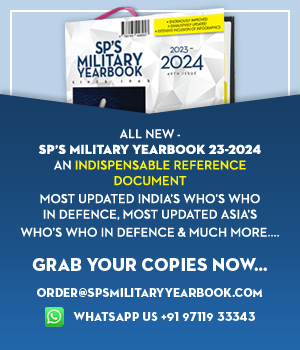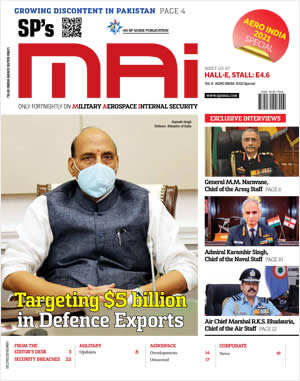INDIAN ARMED FORCES CHIEFS ON OUR RELENTLESS AND FOCUSED PUBLISHING EFFORTS
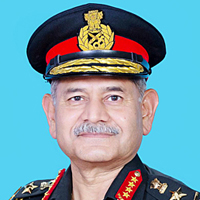
The insightful articles, inspiring narrations and analytical perspectives presented by the Editorial Team, establish an alluring connect with the reader. My compliments and best wishes to SP Guide Publications.
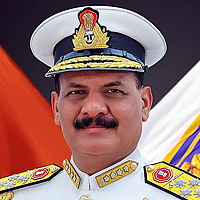
"Over the past 60 years, the growth of SP Guide Publications has mirrored the rising stature of Indian Navy. Its well-researched and informative magazines on Defence and Aerospace sector have served to shape an educated opinion of our military personnel, policy makers and the public alike. I wish SP's Publication team continued success, fair winds and following seas in all future endeavour!"

Since, its inception in 1964, SP Guide Publications has consistently demonstrated commitment to high-quality journalism in the aerospace and defence sectors, earning a well-deserved reputation as Asia's largest media house in this domain. I wish SP Guide Publications continued success in its pursuit of excellence.
- Prime Minister Modi Visits Punjab’s Adampur Air Base, Interacts with Airmen after Successful ‘Operation Sindoor’; Stern Message to Pakistan
- The layered Air Defence systems that worked superbly, the key element of Operation Sindoor
- Operation Sindoor | Day 2 DGMOs Briefing
- Operation Sindoor: India strikes back with Precision and Purpose
- Operation Sindoor: Resolute yet Restrained
- India’s Operation Sindoor Sends a Clear Message to Terror and the World – ‘ZERO TOLERANCE’
- Japan and India set forth a defence cooperation consultancy framework, talks on tank and jet engines
- Terrorist Attack in Pahalgam in Kashmir: Unfolding a long surgical war against PAK
- Lt General Pratik Sharma takes over Command of Indian Army's Northern Command
Renewing ties beneath the waves — US team to visit India for P-8I aircraft deal
This visit, aimed at reinvigorating one of the most important facets of the India-US defence relationship, also aims to further strengthen a critical component of India's maritime surveillance and anti-submarine warfare (ASW) capability — especially given the Indian Ocean Region's (IOR) increasing centrality to global trade and security

In a significant development underscoring the renewed strategic ties between New Delhi and Washington, a high-level US team — comprising officials from the US Department of Defense and Boeing — is set to visit India to revive discussions around the long-stalled $4 billion deal for six additional P-8I maritime patrol aircraft.
This visit, aimed at reinvigorating one of the most important elements of the India-US defence relationship, marks more than just a business transaction; it signals the continued evolution of a strategic partnership grounded in mutual interest, regional stability, and maritime security.
It may well signal a recalibration — a thaw — in the bilateral relationship, one with implications for geopolitics, defence, trade, and strategic trust.
Over the past several months, India–United States ties have weathered a serious chill — trade talks collapsed, Washington imposed steep tariffs on Indian exports, and US criticism of India's continued oil imports from Russia deepened diplomatic friction. In this heated atmosphere, the proposed $4 billion deal for six additional P-8I maritime patrol aircraft takes on far more than its price tag. It may well signal a recalibration — a thaw — in the bilateral relationship, one with implications for geopolitics, defence, trade, and strategic trust.
Over the past 15 years, India has inducted 12 P-8I aircraft, a variant of the P-8A Poseidon used by the US Navy. The aircraft has become a critical component of India's maritime surveillance and anti-submarine warfare (ASW) capability — especially vital given the Indian Ocean Region's (IOR) increasing centrality to global trade and security.
The aircraft has become a critical component of India's maritime surveillance and anti-submarine warfare (ASW) capability — especially vital given the Indian Ocean Region's (IOR) increasing centrality to global trade and security.
The Indian Ocean has, in recent years, seen a steady rise in geopolitical activity — from Chinese naval forays to piracy threats and maritime terrorism. The P-8I fleet, with its state-of-the-art sensors, long-range surveillance, and precision targeting capabilities, has significantly augmented India's ability to monitor, deter, and respond to threats across this crucial stretch of water. An expansion of this fleet would further strengthen India's maritime domain awareness and bolster its deterrence posture across the region.
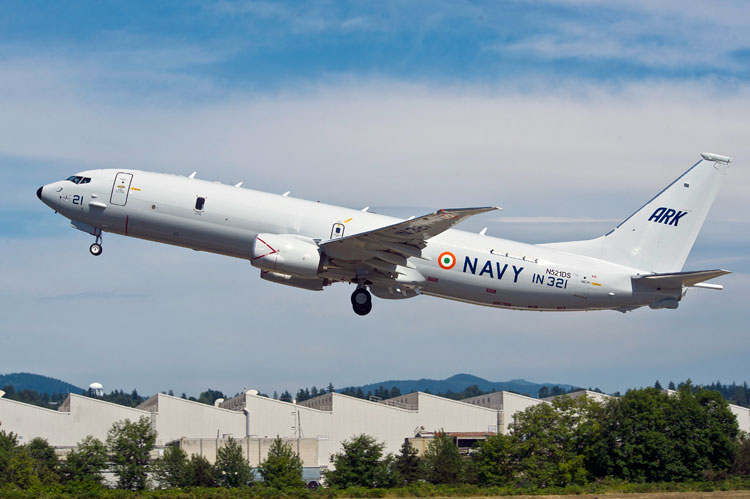
The proposed $4 billion deal, which has seen intermittent delays, is not merely a matter of defence procurement. It sits at the intersection of strategic cooperation, regional balance, and shared democratic values. The upcoming visit by the US team is a clear signal of Washington's willingness to continue working on defence ties and maintain momentum in one of the 21st century's most consequential bilateral relationships.
The P-8I fleet, with its state-of-the-art sensors, long-range surveillance, and precision targeting capabilities, has significantly augmented India's ability to monitor, deter, and respond to threats across this crucial stretch of water.
The importance of this defence cooperation must also be viewed in the context of broader India-US relations. From foundational defence agreements such as COMCASA and BECA to increasingly frequent joint exercises like Malabar, the two countries are laying the groundwork for a long-term strategic partnership.
The Indo-Pacific, with its contested waters and shifting alliances, demands robust maritime capabilities — and India's continued investment in platforms like the P-8I aligns seamlessly with both its national security priorities and broader regional commitments.
The Indo-Pacific, with its contested waters and shifting alliances, demands robust maritime capabilities — and India's continued investment in platforms like the P-8I aligns seamlessly with both its national security priorities and broader regional commitments.
Critically, this deal also reflects the maturing nature of India's defence procurement approach. Unlike past decades of over-reliance on a single supplier or purely transactional relationships, India is now seeking partnerships that enhance its strategic autonomy while ensuring access to cutting-edge technology. The P-8I programme, with its proven operational record, meets these objectives and supports greater interoperability between the Indian and US navies.
However, to unlock the full potential of this partnership, both sides must address bureaucratic and procedural bottlenecks that often delay such high-value procurements. The defence dialogue should be accompanied by a parallel push toward co-production, technology transfer, and deeper industrial cooperation — areas where trust and transparency will be key.
Manish Kumar Jha is a Consulting & Contributing Editor for SP's Aviation, SP's Land Forces and SP's Naval Forces and a security expert. He writes on national security, military technology, strategic affairs & policies.




